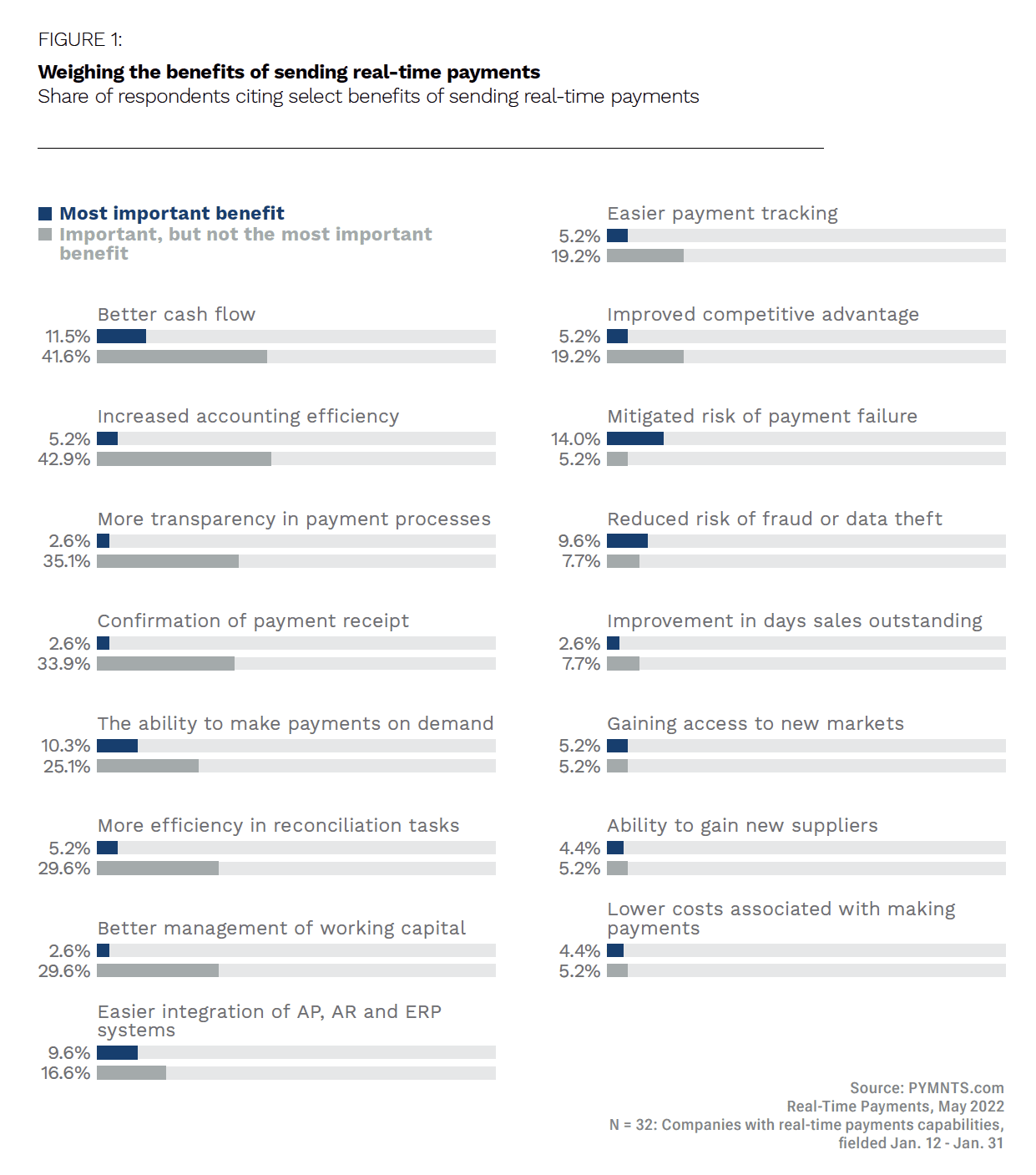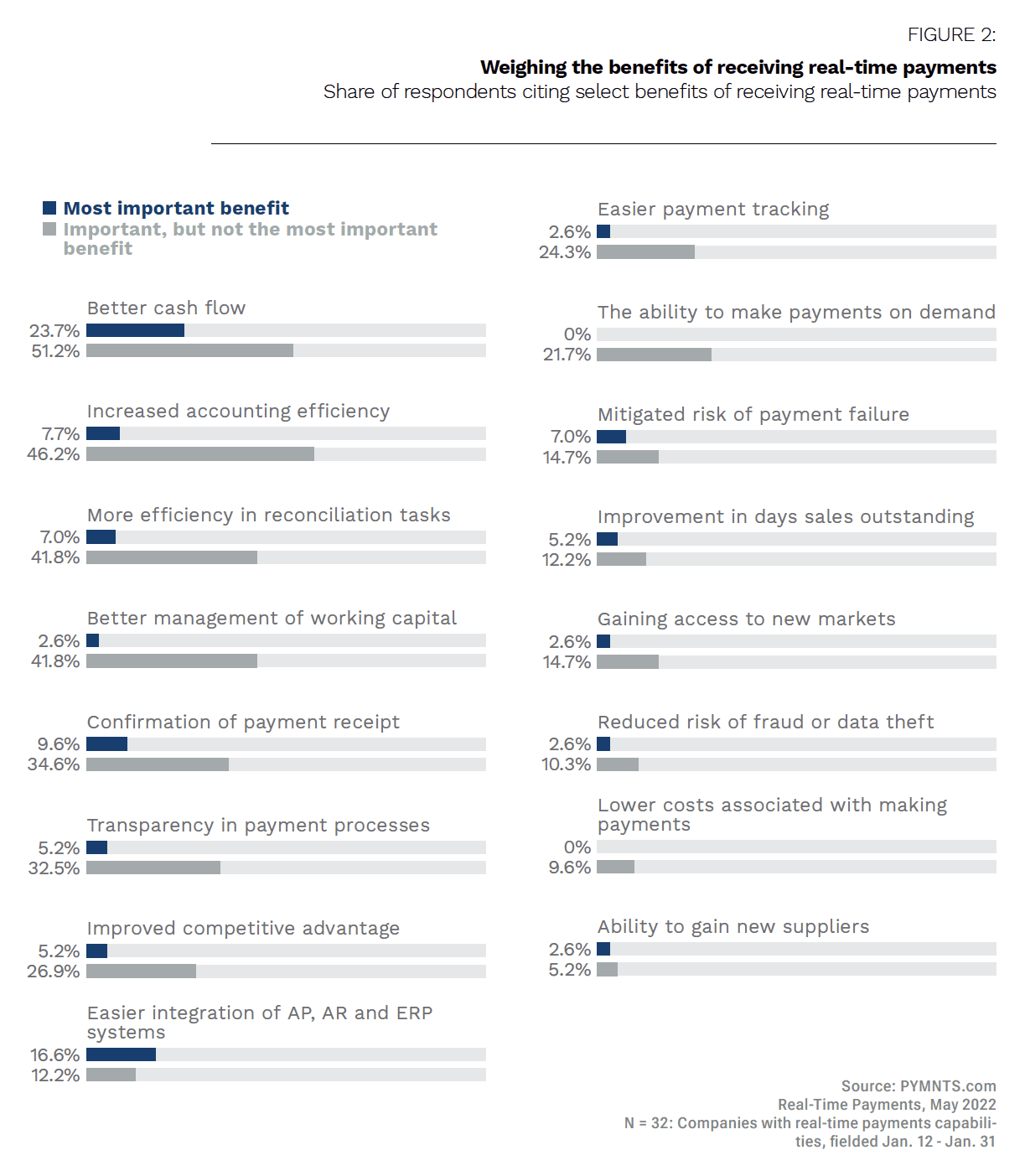While real-time payments currently account for just 2% of corporate payments sent and 1.3% of those received today, corporate treasurers and billing and payment executives are increasingly interested in real-time payments’ potential for improving such areas as cash flow management and efficiency.
Twelve percent of companies currently sending real-time payments cited improved cash flow management as the most important benefit of real-time payments. That share doubled among companies receiving real-time payments. Companies see these cash flow management improvements in areas such as payment reconciliation and working capital management efficiency. Forty-eight percent of surveyed businesses cited accounting efficiency as a benefit of sending real-time payments, while 54% said the same of receiving them. Among senders, 14% cited the reduced risk of payment failure as the most important benefit, while 7% of receivers said the same.
This month, PYMNTS Intelligence examines the benefits of corporate real-time payments and the challenges businesses face when transitioning to making payments in real time. 

The Realized Benefits of Real-Time Payments
Companies using real-time payments have noted several advantages they convey. Recent PYMNTS research revealed that simply having 24/7, year-round access to payment services was the top benefit of real-time payments for United States businesses, as cited by 28%. These firms also reported seeing improvements in cash flow management and data security. At the same time, a company’s size directly impacts how it rates real-time payments’ benefits. Large firms were 78% likelier than midmarket firms to emphasize the added flexibility of real-time payments, while midmarket firms were 74% more likely than large firms to emphasize the 24/7, year-round access these payments offer.
Among companies looking to upgrade their real-time payments systems, 52% said they expect to gain access to new markets, while 50% anticipated gaining new customers and suppliers. Forty-nine percent expect reduced fraud and theft risks from the upgrades, and 44% said they expect a lower risk of payment failure. While there are upfront costs associated with implementing and upgrading systems for real-time payments, 54% of surveyed companies planning to upgrade said they expect the new features will ultimately lower their costs.
Acknowledging the Challenges of Real-Time Payments
Cost is one of the most frequently cited challenges of real-time payments, particularly when first implementing these types of payments. Firms face upfront technology investments as well as the costs of sending and receiving payments. Firms with real-time payments capabilities cited technology costs as the most significant hurdle for sending and receiving real-time payments, at 20% and 18%, respectively. Eleven percent also said the cost of sending real-time payments is the biggest hurdle.
Cost is not the only area in which technology poses a problem, and 11% of firms said delays related to legacy IT challenges were the top hurdle to sending payments in real time. Nearly 14% said the same about receiving them. Some firms have also expressed concerns over the irrevocability of real-time payments. This requires additional due diligence, and some companies are unsure whether they will be ready for real-time payments or have the necessary expertise to handle this matter. Such concerns may have slowed the adoption of real-time payments, even as interest continues to grow.
Distinguishing Perceptions From Reality
The irrevocable nature of real-time payments can raise fears related to fraud, cited by 55% of surveyed Canadian firms as the reason they are not interested in real-time payments, while 24% of uninterested U.S. firms said the same. That contrasts starkly with the 16% of surveyed firms engaged in real-time payments that cite fraud as a problem. Irrevocability was a pain point for 69% of surveyed U.S. firms that engaged in real-time payments, yet actual fraudulent transactions occur just one-quarter as often for them as for firms not using real-time payments.
As with any significant change in how companies do business, real-time payments come with obstacles, yet technology upgrades and learning new systems are not unique challenges to real-time payments. The benefits associated with transacting in real time continue to garner interest, and any firm involved in payments will need to consider its strategy for real-time payments’ eventual ubiquity.

